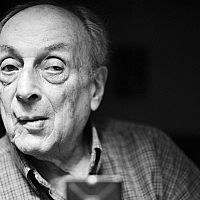
Lucien Hervé, Ronchamp-Notre Dame du Haut, c. 1955, gelatin silver print, image: 4 1/2 x 4 1/2 inches. © Lucien Hervé, collection of Carl Safe.
Expositions du 10/6/2016 au 20/8/2016 Terminé
Sheldon Arts Foundation 3648 Washington Boulevard MO63108 Saint Louis États-Unis
This exhibition features 48 photographs of Notre Dame du Haut (Our Lady of the Height), in Ronchamp, France—a church designed and built by the famed modern architect, Le Corbusier between 1950 and 1955. The church is one of the most significant projects of Le Corbusier’s career and has been called “the 20th century’s greatest masterwork” by Herbert Munchamp, architectural critic of The New York Times. The photographs made by Lucien Hervé include images of the church in various stages of construction, as well as photos of Le Corbusier’s models and photos of preliminary sketches for the structure.Sheldon Arts Foundation 3648 Washington Boulevard MO63108 Saint Louis États-Unis
A pilgrimage church has stood on this site since the 11th century and the structure preceding that of Le Corbusier was destroyed by the Nazis during the resistance in 1944. Le Corbusier used stone rubble from that destruction to build the walls of the new chapel. Notre Dame du Haut serves as a symbol of spiritual continuity, a memorial to those killed in the 1944 attack and as the paradigmatic example of architecture’s capacity to lift the human spirit.
One of the most distinctive components of the building is the roof which consists of two concrete membranes separated by 7.5 feet forming a hollow shell. Some have said it is derivative of the hats worn by nuns of the period, while others believe it to be a reference to the wing of an airplane. Le Corbusier offered no explanation. This roof acts to insulate and create a watertight barrier and rests on top of short struts, which form part of a vertical surface of concrete covered with gunnite. These struts act to brace the walls of old Vosges stone, a remnant of the former chapel destroyed in war-time bombings. Le Corbusier’s design did not necessitate buttressing, a common support in older cathedrals, but instead, its curvilinear forms supply support and stability to the rough masonry. The interior is lit by a system of openings covered with clear glass, and, in places, with colored glass, however there are no traditional stained glass windows. Le Corbusier considered traditional stained glass windows to be too closely bound to old architectural ideas. His windows allow the outside world entry—through them one can see the clouds, the movement of foliage and even passers-by.
The floor of the chapel follows the natural slope of the hill down towards the altar. It is constructed of a cement paving, poured in place between battens, the design of which is dictated by Le Corbusier’s “Modulor” system for the anthropometric scale of architectural proportion. Certain parts of the floor and the altars on which they stand are composed of a beautiful white stone from Bourgogne. The towers are constructed of stone masonry and are capped by cement domes. The vertical elements of the chapel are surfaced with mortar sprayed on with a cement gun and whitewashed on both the interior and exterior. The concrete shell of the roof is left rough and is imprinted with the formwork.
Born in Hungary in 1910, Hervé emigrated to France in 1929. His career as a magazine reporter and photographer was transformed when Le Corbusier told him, “You have the soul of an architect.” From that point on, he was commissioned to photograph Le Corbusier’s work. Hervé’s view was that of an artist. He believed that the spirit of a building is most effectively represented by fragmented compositional abstractions. “Just a minute detail can be sufficient to capture the essence of something. I purify my photos until they contain no meaningless elements,” he wrote.
Le Corbusier was born Charles-Edouard Jeanneret-Gris in Switzerland in 1887. He moved to Paris and assumed the pseudonym “Le Corbusier” in 1917. An architect, designer, painter, urban planner, writer, furniture designer and one of the pioneers of what is now called modern architecture, Le Corbusier’s career spanned five decades with buildings constructed throughout Europe, India and the Americas. Some of his best known are Notre Dame du Haut in Ronchamp, France, Unité d’Habitation, or the “Radiant City,” in Marseilles, France and the Villa Savoye in Poissy, France.

